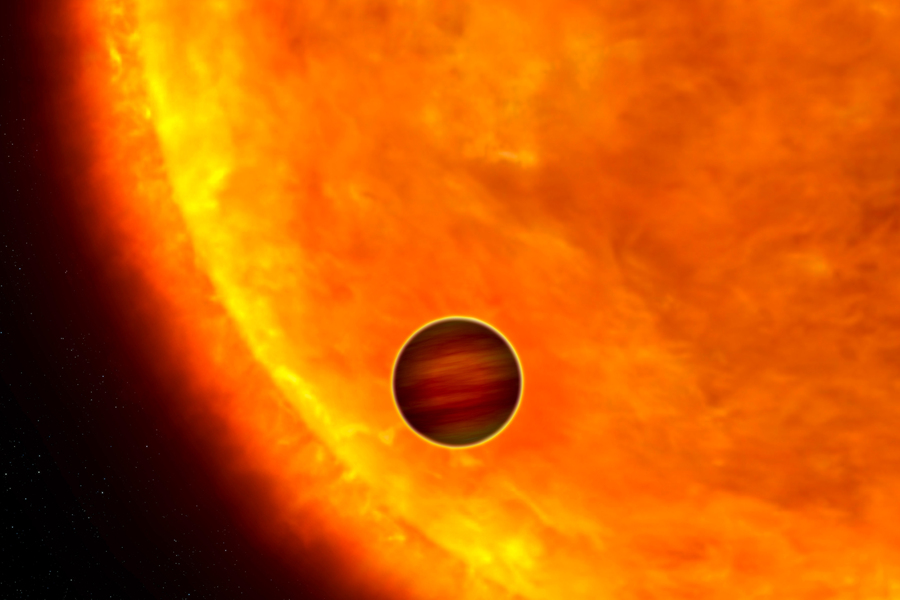
Contrary to popular opinion, there are NOT 525,600 minutes in a year. That’s because the Earth takes more than 365 days to circle the Sun and come back to the same place (although defining “the same place” is non-trivial). Modern calendar systems assume 365.2422 days in a year, which works out to 525,948.768 minutes — it doesn’t quite roll off the tongue the same way, but it does give you almost 349 more seasons of love.
But that’s just for Earth. If you lived on one of the most recently discovered exoplanets, you would have fewer than a thousand love seasons. That’s because this planet, the ultra-hot Jupiter TOI-2109 b, circles its star once every 16 hours. But the fate of TOI-2109 b-ian lovers is sealed not just by their short seasons but because their planet is doomed, a sad destiny foretold by a French physicist who saw his own world rent to pieces.
La Vie Bohème
Édouard Albert Roche was born to a family of academics in 1820, five years after the final surrender of Napoleon. Roche reached a (no doubt) precocious nine before, in 1830, the July Revolution swept out King Charles X and created a constitutional monarchy. And shortly after Roche completed his doctoral research in mathematical physics, the February Revolution in 1848 established a new constitutional regime, which itself ended four years later when Napoleon’s nephew, Napoleon III, promoted himself from president to emperor. In the midst of these repeated societal disruptions, Roche explored another kind of disruption, one that could shatter physical worlds instead of just political ones.

Since the discovery of Saturn’s rings by Galileo, their nature had remained a mystery. Work in the mid-1600s by Huygens showed that the rings could not be solid, but exactly what they were was unclear. Roche tackled the question of the nature of the rings from the other end, wondering how they might have originated. Roche wondered, “How close could a small body get to Saturn before being ripped apart?”

For a satellite orbiting a planet, the side nearest the planet feels a slightly stronger gravitational pull than the far side. These two pulls produce a stretching force that tries to elongate the satellite. The closer the satellite is to the planet, the stronger the stretching, and if it exceeds the force holding the satellite together, then the satellite will disintegrate. In honor of Roche’s ground-breaking analysis, the distance at which this disintegration occurs was named the “Roche limit”.
Roche suggested this is how Saturn’s rings formed: a satellite spiral into its Roche limit and was torn apart.
I’ll (Dis)cover You
These same disruptive forces that brought us the jewel of the Solar System threatens the newly discovered exoplanet TOI-2109 b. Dr. Ian Wong, a postdoc at NASA, led the discovery paper, pummeling the planet with a battery of follow-up observations to probe its properties.
Starting with data from NASA’s TESS Mission, Dr. Wong and colleagues spotted the tell-tale signs of a planetary shadow originating from an F-star about 850 light years from Earth. The depth of the shadow signal indicated the planet was about the size of Jupiter, but it recurred every 16 hours, giving TOI-2109 b the shortest orbital period for any known gas giant. Wong and colleagues even caught a glimpse of the planet’s day side, which allowed them to estimate its temperature — a whopping 3,500 degrees Kelvin or 6,000 degrees Fahrenheit, as hot as some stars.
Wong and colleagues probed the planet’s precarious position by resurrecting Roche’s 19th century analysis to calculate TOI-2109 b’s Roche limit. Although the planet currently orbits so close to its star its atmosphere is blast-heated to a plasma, they estimated that its Roche limit is even closer in, corresponding to a orbital period of 3 hours. So the planet is safe?

Actually, no. The same forces emanating from the star that stretch the planet also emanate from the planet, stretching the star. Astronomers have shown that this stellar stretching can cause exoplanets as close-in as TOI-2109 b to spiral in toward their stars over millions of years. In fact, this death spiral has been observed in action for other hot Jupiters. Wong and colleagues predict that TOI-2109’s death spiral might take as little as 90,000 years!
And so, as short as the seasons of love currently are TOI-2109 b, they promise to get even shorter. What will happen to TOI-2109 b when it reaches its Roche limit? As for Saturn’s rings, the planet will disintegrate and may form an accretion disk around the star, the gas equivalent of a planetary ring system. This disk will then slowly trickle into the star, removing almost all traces of the planet.
So to any TOI-2109 b-ians, time is short. Gather your rosebuds while you may ’cause it looks like there’s no day but today.
